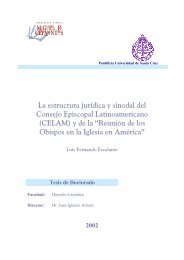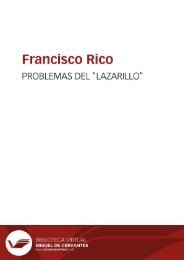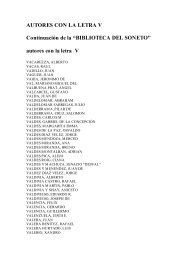Create successful ePaper yourself
Turn your PDF publications into a flip-book with our unique Google optimized e-Paper software.
Anales galdosianos [Publicaciones periódicas]. Año XII, 1977<br />
Manuel, Máximo writes a paragraph of resounding reproaches in the best declamatory style, but he<br />
then represents that outburst as hypothetical and opts for simplicity, thereby slapping at the practices<br />
of others. When Manso's taste lapses or when he takes liberties with his own standards, then the text's<br />
self-consciousness turns his self-consciousness into self-parody, as in the following jocular displays:<br />
« Doña Javiera era... (me molesta el sonsonete, pero no lo puedo evitar) viuda » (IV, 21); « Esto le<br />
dije; estuve elocuente, y un sí es no es sutil o caballeresco » (XXXIV, 209); « Usando una figura de<br />
género místico y muy bella, aunque algo gastada por el uso de tantas manos de poetas y teólogos, diré<br />
que algún ángel había descendido a mí y consoládome durante mi sueño » (XXXIX, 244-45). 143<br />
If El amigo Manso is an examination and revelation of its generic self, it is natural that its parodic<br />
component should also be directed against the novel and the novel's medium, language. Throughout<br />
the work <strong>Galdós</strong> satirizes the commonplaces and the spent formulas of novel writing. The surprising<br />
shape he gave to El amigo Manso -not his most deeply human novel but certainly his most brilliant<br />
tour de force- is his cry for originality and for renovation of the genre 144 . In its focus on its own raw<br />
material, this novel already demonstrates its literariness, and in its relentless attack on the rhetorical<br />
tradition, it subjects the word to destruction through the word. It annihilates the signifier that has<br />
suffered the loss of its signified (a social commentary via language) and thereby subverts the sign<br />
143 The use of dreams as a narrative device also finds its open justification in this novel. At one point<br />
Manso recounts a nightmare he had and concludes by ridiculing the stale device of the surprise-ending<br />
tale: « Concluiré esta febril jornada diciendo con la candidez de los autores de cuentos, después que<br />
se han despachado a su gusto narrando los más locos desatinos: / Entonces desperté. Todo había sido<br />
un sueño » (XXV, 151). But he reverses the satirical thrust when he sees in the dream he had an<br />
indecipherable logic that connects it to his wakeful state of the evening before. With further thought,<br />
Manso succeeds in relating the dream to events in reality and endowing it with an equal measure of<br />
truth. The result is, on the one hand, a justification on <strong>Galdós</strong>' part for the inclusion of dreams in<br />
his novels and, on the other, a moment's insight into his deep understanding of the function of the<br />
dream in the human psyche. Most significantly, the act of dreaming is posited as yet another creative<br />
process, a fictive construct built on reality.<br />
144 Nimetz (p. 61) understands that <strong>Galdós</strong> has used Manso's narration to cast barbs at stagnant<br />
artistic modes and to suggest that art requires constant reinvigoration. Had he stood farther back from<br />
Manso's words, Nimetz would have seen that all of El amigo Manso is in itself a rejection of antiquated<br />
artistic patterns.<br />
106

















